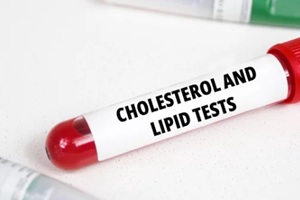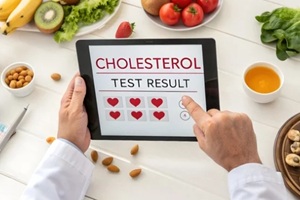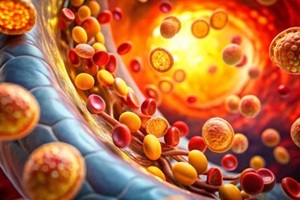 Cholesterol tests are among the most important practices for your heart health. However, you may have noticed varying terminology. What exactly is the difference between a lipid panel and a cholesterol screening?
Cholesterol tests are among the most important practices for your heart health. However, you may have noticed varying terminology. What exactly is the difference between a lipid panel and a cholesterol screening?
This blog will help you understand basic terms, concepts, and expectations related to cholesterol screenings.
Comprehending the Basics of Cholesterol
Cholesterol is a fat with a waxy consistency that travels through your bloodstream. Your body needs some cholesterol to build healthy cells, but too much can lead to heart disease and stroke.
When you get your cholesterol checked, you’re getting a measurement of the total cholesterol circulating in your blood. This important test helps assess your risk of developing cardiovascular problems.
However, there are a few different types of cholesterol tests. Grasping the differences between a cholesterol screening and a lipid panel can help you better interpret your results.
What Is Cholesterol Screening?
A cholesterol screening is a simple blood test that measures your total blood cholesterol level. This test determines the amount of cholesterol in your blood sample, which includes:
- LDL (low-density lipoprotein) cholesterol is known as “bad” cholesterol because it can stick to artery walls and increase your risk of heart attack and stroke.
- HDL (high-density lipoprotein) cholesterol is considered “good” cholesterol because it carries LDL cholesterol back to your liver so your body can get rid of it. Higher levels may lower your heart disease risk.
- VLDL (very-low-density lipoprotein) cholesterol is another “bad” type that’s linked to atherosclerosis and cardiovascular disease.
The screening provides your total cholesterol level but doesn’t differentiate between HDL, LDL and VLDL. Just getting your total number can help determine if your cholesterol is higher than recommended. Yet without the complete breakdown, it doesn’t reveal if you have imbalanced levels of good and bad cholesterol.
What Is a Lipid Panel?
While a cholesterol screening only reports total cholesterol, a lipid panel is more complex. This blood test provides a complete cholesterol breakdown by measuring individual lipid components. It reports:
- Total cholesterol
- LDL cholesterol
- HDL cholesterol
- Triglycerides (a fat that can increase heart disease risk)
The lipid panel results offer a snapshot of your cholesterol balance between HDL and LDL. This test helps you and your doctor better evaluate your risk level for cardiovascular disease. Imbalanced cholesterol levels are a major controllable risk factor for heart attack and stroke.
Main Differences Between Cholesterol Screenings and Lipid Panels
Two main differences distinguish these cholesterol tests:

- A cholesterol screening only measures total blood cholesterol, while a lipid panel provides a complete cholesterol breakdown. With the screening, you only get your total cholesterol number. However, your risk depends greatly on the ratio of your LDL, HDL, and other lipid components. The lipid panel reports each element separately, giving a more accurate picture.
- Whereas a cholesterol screening does not measure triglycerides, they’re included in lipid panel testing. Triglycerides are another type of fat in your blood that contributes to high levels of heart disease.
Getting Tested: What to Expect
Both cholesterol tests only require a small blood sample, taking just a few minutes at your doctor’s office or a clinical lab. For the most reliable results, it’s best to fast for 9 to 12 hours beforehand. That means avoiding all food and drink except water leading up to your test.
A phlebotomist will clean and sterilize your arm before drawing your blood sample through a small needle. This process is minimally invasive and you may only have slight discomfort at the puncture site.
Your doctor will analyze the results and may want to recheck your cholesterol every few years or more often if you have high levels or existing heart issues. Maintaining healthy cholesterol greatly reduces your risks of cardiovascular disease as you age.
Which Test Do You Need?
If your doctor orders general cholesterol testing and you’re unsure which one you’re getting, don’t hesitate to ask for clarification. Knowing the exact tests performed is important for understanding your results. But when should you get a cholesterol screening and when do you need a lipid panel?
Get a cholesterol screening if:
- You need an initial baseline for your total blood cholesterol level. This can help determine if more testing is needed.
- You’re monitoring total cholesterol response after making lifestyle changes to lower your levels through a healthy diet, exercise, and quitting smoking.
Get a lipid panel if:
- You need to grasp your complete cholesterol profile, including LDL, HDL, and triglycerides. This test helps accurately evaluate heart disease risk.
- Your doctor recommends full lipid testing to diagnose potential cardiovascular issues.
- You’re tracking your lipid panel results while taking cholesterol-lowering medications.
Comprehending Your Results
 Make sure to go through your test results with your doctor carefully. Ask them to explain each component and whether your levels are a health concern. If your results are abnormal, additional testing may be needed to uncover potential underlying causes.
Make sure to go through your test results with your doctor carefully. Ask them to explain each component and whether your levels are a health concern. If your results are abnormal, additional testing may be needed to uncover potential underlying causes.
Determine the Right Test for You with Imperial Center Family Medicine
Staying on top of recommended cholesterol testing is essential for maintaining heart health. If you’re not sure if you should get a cholesterol screening or lipid panel, Imperial Center Family Medicine’s specialists can help determine what’s right for your situation and risk factors. Contact us today at 919-873-4437 or online to evaluate your heart disease risk and receive recommendations for appropriate cholesterol testing.
